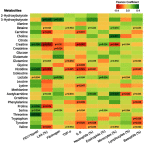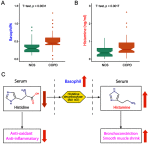Disruption of histidine and energy homeostasis in chronic obstructive pulmonary disease
- PMID: 31564849
- PMCID: PMC6732562
- DOI: 10.2147/COPD.S210598
Disruption of histidine and energy homeostasis in chronic obstructive pulmonary disease
Abstract
Background: Chronic obstructive pulmonary disease (COPD) is a systemic condition that is too complex to be assessed by lung function alone. Metabolomics has the potential to help understand the mechanistic underpinnings that contribute to COPD pathogenesis. Since blood metabolomics may be affected by sex and body mass index (BMI), the aim of this study was to determine the metabolomic variability in male smokers with and without COPD who have a narrow BMI range.
Methods: We compared the quantitative proton nuclear magnetic resonance acquired serum metabolomics of a male Chinese Han population of non-smokers without COPD, and smokers with and without COPD. We also assessed the impact of smoking status on metabolite concentrations and the associations between metabolite concentrations and inflammatory markers such as serum interleukin-6 and histamine, and blood cell differential (%). Metabolomics data were log-transformed and auto-scaled for parametric statistical analysis. Mean normalized metabolite concentration values and continuous demographic variables were compared by Student's t-test with Welch correction or ANOVA with post-hoc Tukey's test, as applicable; t-test p-values for metabolomics data were corrected for false discovery rate (FDR). A Pearson association matrix was built to evaluate the relationship between metabolite concentrations, clinical parameters and markers of inflammation.
Results: Twenty-eight metabolites were identified and quantified. Creatine, glycine, histidine, and threonine concentrations were reduced in COPD patients compared to non-COPD smokers (FDR ≤15%). Concentrations of these metabolites were inversely correlated with interleukin-6 levels. COPD patients had overall dampening of metabolite concentrations including energy-related metabolic pathways such as creatine metabolism. They also had higher histamine levels and percent basophils compared to smokers without COPD.
Conclusion: COPD is associated with alterations in the serum metabolome, including a disruption in the histidine-histamine and creatine metabolic pathways. These findings support the use of metabolomics to understand the pathogenic mechanisms involved in COPD.Trial registration www.clinicaltrials.gov, NCT03310177.
Keywords: China; chronic obstructive pulmonary disease; energy homeostasis; histidine; inflammation; metabolomics.
© 2019 Diao et al.
Conflict of interest statement
Dr MeiLan Han reports personal fees from BI, GSK, AZ and research support from Novartis and Sunovion, outside of the submitted work. The authors report no other conflicts of interest in this work.
Figures



References
Publication types
MeSH terms
Substances
Associated data
Grants and funding
LinkOut - more resources
Full Text Sources
Medical

